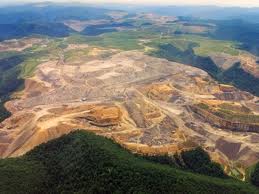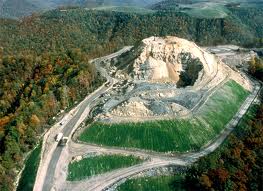 Last night I went to see the film The Last Mountain, an incredibly powerful documentary that chronicles the struggle of West Virginian communities against the pulverization of their land and lives by coal mining outfits like Massey Energy Corporation.
Last night I went to see the film The Last Mountain, an incredibly powerful documentary that chronicles the struggle of West Virginian communities against the pulverization of their land and lives by coal mining outfits like Massey Energy Corporation.
As these photographs suggest, mountaintop removal, a process used by Massey and other companies to mine coal with little manpower, is unbelievably destructive in environmental terms. The corporations involved are literally creating a moonscape in the Appalachians, all in the name of greed. Unfortunately, as The Last Mountain shows, many coal miners support such short sighted attitudes because they are afraid that they will lose their jobs if they don’t comply with the greed of their bosses.
The resilience and determination of individuals who challenge mountaintop removal, which has corrupted not just the air and creeks of the mountains of the Appalachians but also the political process and regulatory agencies such as West Virginia’s EPA, is really inspiring. The film contains a series of stirring portraits of local citizen-activists who  have risen up in opposition to the tide of cancer, pulmonary disease, and physical displacement that has swept across their rural communities.
have risen up in opposition to the tide of cancer, pulmonary disease, and physical displacement that has swept across their rural communities.
The film also does a nice job in showing how outside activists, from celebrity environmental lawyers like Robert F. Kennedy Jr. to young radicals with the climate justice movement, can help leverage local people’s protests.
I was also particularly impressed by The Last Mountain‘s ability to situate these struggles in relation to the broader struggle for climate justice. The film explains the toxic byproducts of electricity derived from coal and argues powerfully for a different, renewable energy system.
 Protest around mountaintop removal (MTR) coal mining is heating up. Last month Appalachian activists led a five-day March on Blair Mountain to protest MTR. It just so happened that one of the people at the screening of The Last Mountain was a West Virginian who’d been involved in the march. The link above features lots of audio tracks from the march, but I hope to do an interview with the guy I met at the screening and post it here – keep your eyes open for this.
Protest around mountaintop removal (MTR) coal mining is heating up. Last month Appalachian activists led a five-day March on Blair Mountain to protest MTR. It just so happened that one of the people at the screening of The Last Mountain was a West Virginian who’d been involved in the march. The link above features lots of audio tracks from the march, but I hope to do an interview with the guy I met at the screening and post it here – keep your eyes open for this.
In addition, earlier this week, activists Catherine-Ann MacDougal and Becks Kolins began a tree-sit to block Alpha Natural Resources strip mining operations on Coal River Mountain. The banners they’ve suspended from their tree-sits 80 feet in the air read “STOP STRIP MINING” and “FOR JUDY BONDS,” the latter being a reference to an Appalachian anti-MTR leader who died earlier this year of cancer. Judy’s daughter, Lisa Henderson, said in support of the tree-sit, “I hope that today’s actions serve as a symbol that the struggle to live peacefully and pollution-free in the Coal River Valley did not end when my mother’s life did. My mother and I often compared the fight to survive here on Coal River to the civil rights struggles of the 1960s. I am sure that generations from now, our children will look back on this movement also and the actions of the people involved, and ask the question of their elders, ‘Whose side were you on?’”
As The Last Mountain shows, tree-sitting is a dangerous and grueling form of non-violent direct action, with mining  companies often using ear-splitting noise machines similar to those deployed by the U.S. military in Iraq in order to try to break the morale of protesters. We should try to lend the activists support with solidarity actions and letter writing campaigns to local papers.
companies often using ear-splitting noise machines similar to those deployed by the U.S. military in Iraq in order to try to break the morale of protesters. We should try to lend the activists support with solidarity actions and letter writing campaigns to local papers.
Other protest actions relating to Climate Justice are on the horizon. On August 4th, community members are calling for direct action at BP’s New Orleans offices in protest of the oil company’s continued lack of accountability for the devastating oil spill.
In addition, in late August and early September, thousands are converging and risking arrest over 15 days at the White House in protest of the Keystone XL pipeline.
Time to heat things up for Killer Coal and other dinosaur extractive industries.